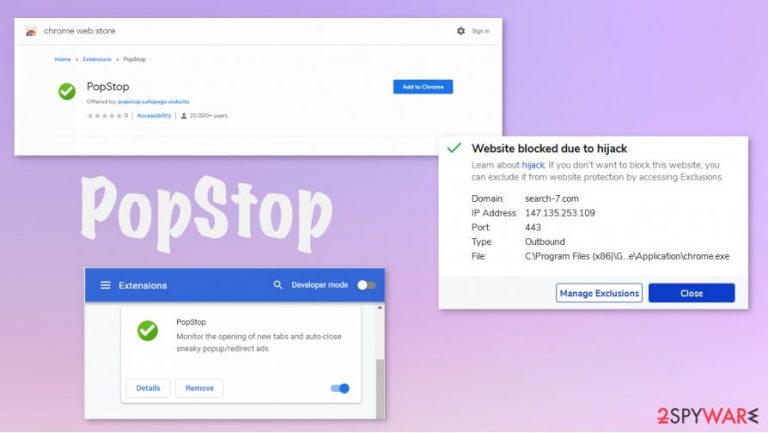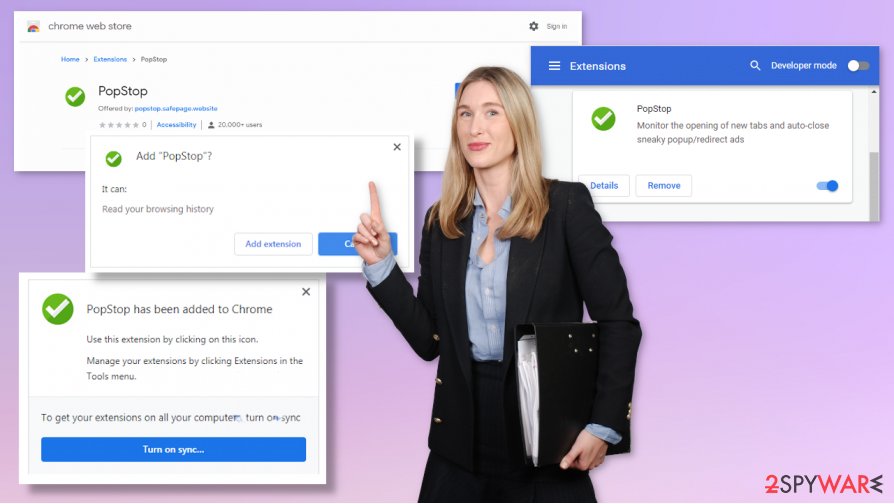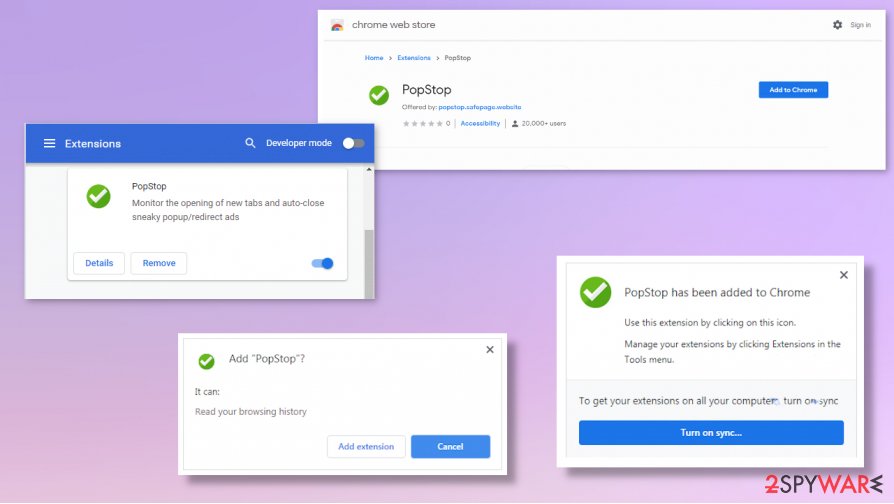PopStop (Free Guide) - Removal Instructions
PopStop Removal Guide
What is PopStop?
PopStop is the search redirect virus that triggers unwanted changes in the browser

PopStop virus is the result of the potentially unwanted application that triggers all the changes in the background, system folders, other parts of the system, and the web browser directly. It significantly affects the speed and performance of your Google Chrome, Internet Explorer, Safari, Mozilla Firefox when redirects, banners, pop-ups start filling up your screen during each online browsing session.
| Name | PopStop |
|---|---|
| Type | Browser hijacker/ Potentially unwanted browser application |
| Issues | The program triggers redirects and tons of pop-ups, banners, unwanted content that gets delivered on the screen directly, so you cannot access the valuable content initially |
| Distribution | The program mainly gets downloaded by the user during the freeware installation that relies on software bundling methods. Also, other PUPs can trigger such infections |
| Elimination | To remove PopStop properly, you should rely on anti-malware tools that can find and delete all these intruders automatically. Security tools are the best for such PUPs |
| Recovery | Remember that unwanted programs can also affect the performance by triggering changes in the system, so run FortectIntego or a different PC repair tool that can find and possibly fix those affected files or corrupted programs |
Even though there are tools like PopStop on Chrome Web Store, this is not a pop-up blocker as many advertisements can claim. This is nothing but a useless browser application that makes a huge difference in the performance of the computer due to redirects, advertising pop-ups.
PopStop is a search hijacker that is categorized as a PUP by researchers due to detection rates, names that appear on the AV scan when this app is running on the machine. Yous start page, new tab settings get changes right after the infection because PUP developers need to reroute people to sponsored sites and collect views, clicks, page visits.
You should remove PopStop as soon as you notice the suspicious tool added on the browser because once the application gets installed on the Chrome browser it can affect the automatic function of opening tabs, trigger the installation of other browser-based programs and even track data about your habits online.

The particular site is detected by anti-malware tools as PUP or a suspicious file. Experts[3] always not that AV tools are needed to keep machine secure and virus free. In these cases, when you have a PUP already, an anti-malware tool can work for the best PopStop removal since the AV engine indicates the threat.
Do not forget about shady businesses related to PopStop and associated programs, advertisers, PUP developers. Your machine gets affected from the inside, so all the symptoms that you can notice are only the ones displayed before you. PUP triggers other issues that need to get fixed, so find a reliable tool like FortectIntego and find parts of the OS that need fixing.

Sneaky methods of PUP distribution
Potentially unwanted programs get installed without users' knowledge, and mainly users cannot notice the infiltration, even though they let these tools to alter settings or access information. When freeware installations get triggered via pirating service or shady distribution page, you need to choose Advanced or Custom options, so all the components are visible.
Avoid any suspicious sites, de-select applications from the list that you get to see, and download only those programs that you are sure about. Rogue tools can easily trigger installations of more applications, so your device can get affected by more programs without your knowledge.
Start PopStop PUP removal process right away
PopStop virus is not the best term to describe the intruder because this add-on, other browser applications, and pop-ups that you encounter are results of the PUP infection only. The virus is the one that affects your system files and programs, functions.
PopStop removal is the process that can be difficult because if the stealthy infiltration factor. So you should find a reliable anti-malware tool and run that on the system. A full system scan checks various parts of the machine and triggers the proper elimination of any malicious file.
As for the system damage, you can use a PC repair or optimization tool. First, you need to remove PopStop thoroughly, and then recover functions on the web browser. Once that is done, scan the machine using repair application and follow suggested fixing procedures.
You may remove virus damage with a help of FortectIntego. SpyHunter 5Combo Cleaner and Malwarebytes are recommended to detect potentially unwanted programs and viruses with all their files and registry entries that are related to them.
Getting rid of PopStop. Follow these steps
Uninstall from Windows
Instructions for Windows 10/8 machines:
- Enter Control Panel into Windows search box and hit Enter or click on the search result.
- Under Programs, select Uninstall a program.

- From the list, find the entry of the suspicious program.
- Right-click on the application and select Uninstall.
- If User Account Control shows up, click Yes.
- Wait till uninstallation process is complete and click OK.

If you are Windows 7/XP user, proceed with the following instructions:
- Click on Windows Start > Control Panel located on the right pane (if you are Windows XP user, click on Add/Remove Programs).
- In Control Panel, select Programs > Uninstall a program.

- Pick the unwanted application by clicking on it once.
- At the top, click Uninstall/Change.
- In the confirmation prompt, pick Yes.
- Click OK once the removal process is finished.
Delete from macOS
Remove items from Applications folder:
- From the menu bar, select Go > Applications.
- In the Applications folder, look for all related entries.
- Click on the app and drag it to Trash (or right-click and pick Move to Trash)

To fully remove an unwanted app, you need to access Application Support, LaunchAgents, and LaunchDaemons folders and delete relevant files:
- Select Go > Go to Folder.
- Enter /Library/Application Support and click Go or press Enter.
- In the Application Support folder, look for any dubious entries and then delete them.
- Now enter /Library/LaunchAgents and /Library/LaunchDaemons folders the same way and terminate all the related .plist files.

Remove from Microsoft Edge
Delete unwanted extensions from MS Edge:
- Select Menu (three horizontal dots at the top-right of the browser window) and pick Extensions.
- From the list, pick the extension and click on the Gear icon.
- Click on Uninstall at the bottom.

Clear cookies and other browser data:
- Click on the Menu (three horizontal dots at the top-right of the browser window) and select Privacy & security.
- Under Clear browsing data, pick Choose what to clear.
- Select everything (apart from passwords, although you might want to include Media licenses as well, if applicable) and click on Clear.

Restore new tab and homepage settings:
- Click the menu icon and choose Settings.
- Then find On startup section.
- Click Disable if you found any suspicious domain.
Reset MS Edge if the above steps did not work:
- Press on Ctrl + Shift + Esc to open Task Manager.
- Click on More details arrow at the bottom of the window.
- Select Details tab.
- Now scroll down and locate every entry with Microsoft Edge name in it. Right-click on each of them and select End Task to stop MS Edge from running.

If this solution failed to help you, you need to use an advanced Edge reset method. Note that you need to backup your data before proceeding.
- Find the following folder on your computer: C:\\Users\\%username%\\AppData\\Local\\Packages\\Microsoft.MicrosoftEdge_8wekyb3d8bbwe.
- Press Ctrl + A on your keyboard to select all folders.
- Right-click on them and pick Delete

- Now right-click on the Start button and pick Windows PowerShell (Admin).
- When the new window opens, copy and paste the following command, and then press Enter:
Get-AppXPackage -AllUsers -Name Microsoft.MicrosoftEdge | Foreach {Add-AppxPackage -DisableDevelopmentMode -Register “$($_.InstallLocation)\\AppXManifest.xml” -Verbose

Instructions for Chromium-based Edge
Delete extensions from MS Edge (Chromium):
- Open Edge and click select Settings > Extensions.
- Delete unwanted extensions by clicking Remove.

Clear cache and site data:
- Click on Menu and go to Settings.
- Select Privacy, search and services.
- Under Clear browsing data, pick Choose what to clear.
- Under Time range, pick All time.
- Select Clear now.

Reset Chromium-based MS Edge:
- Click on Menu and select Settings.
- On the left side, pick Reset settings.
- Select Restore settings to their default values.
- Confirm with Reset.

Remove from Mozilla Firefox (FF)
Remove dangerous extensions:
- Open Mozilla Firefox browser and click on the Menu (three horizontal lines at the top-right of the window).
- Select Add-ons.
- In here, select unwanted plugin and click Remove.

Reset the homepage:
- Click three horizontal lines at the top right corner to open the menu.
- Choose Options.
- Under Home options, enter your preferred site that will open every time you newly open the Mozilla Firefox.
Clear cookies and site data:
- Click Menu and pick Settings.
- Go to Privacy & Security section.
- Scroll down to locate Cookies and Site Data.
- Click on Clear Data…
- Select Cookies and Site Data, as well as Cached Web Content and press Clear.

Reset Mozilla Firefox
If clearing the browser as explained above did not help, reset Mozilla Firefox:
- Open Mozilla Firefox browser and click the Menu.
- Go to Help and then choose Troubleshooting Information.

- Under Give Firefox a tune up section, click on Refresh Firefox…
- Once the pop-up shows up, confirm the action by pressing on Refresh Firefox.

Remove from Google Chrome
Delete malicious extensions from Google Chrome:
- Open Google Chrome, click on the Menu (three vertical dots at the top-right corner) and select More tools > Extensions.
- In the newly opened window, you will see all the installed extensions. Uninstall all the suspicious plugins that might be related to the unwanted program by clicking Remove.

Clear cache and web data from Chrome:
- Click on Menu and pick Settings.
- Under Privacy and security, select Clear browsing data.
- Select Browsing history, Cookies and other site data, as well as Cached images and files.
- Click Clear data.

Change your homepage:
- Click menu and choose Settings.
- Look for a suspicious site in the On startup section.
- Click on Open a specific or set of pages and click on three dots to find the Remove option.
Reset Google Chrome:
If the previous methods did not help you, reset Google Chrome to eliminate all the unwanted components:
- Click on Menu and select Settings.
- In the Settings, scroll down and click Advanced.
- Scroll down and locate Reset and clean up section.
- Now click Restore settings to their original defaults.
- Confirm with Reset settings.

Delete from Safari
Remove unwanted extensions from Safari:
- Click Safari > Preferences…
- In the new window, pick Extensions.
- Select the unwanted extension and select Uninstall.

Clear cookies and other website data from Safari:
- Click Safari > Clear History…
- From the drop-down menu under Clear, pick all history.
- Confirm with Clear History.

Reset Safari if the above-mentioned steps did not help you:
- Click Safari > Preferences…
- Go to Advanced tab.
- Tick the Show Develop menu in menu bar.
- From the menu bar, click Develop, and then select Empty Caches.

After uninstalling this potentially unwanted program (PUP) and fixing each of your web browsers, we recommend you to scan your PC system with a reputable anti-spyware. This will help you to get rid of PopStop registry traces and will also identify related parasites or possible malware infections on your computer. For that you can use our top-rated malware remover: FortectIntego, SpyHunter 5Combo Cleaner or Malwarebytes.
How to prevent from getting browser hijacker
Stream videos without limitations, no matter where you are
There are multiple parties that could find out almost anything about you by checking your online activity. While this is highly unlikely, advertisers and tech companies are constantly tracking you online. The first step to privacy should be a secure browser that focuses on tracker reduction to a minimum.
Even if you employ a secure browser, you will not be able to access websites that are restricted due to local government laws or other reasons. In other words, you may not be able to stream Disney+ or US-based Netflix in some countries. To bypass these restrictions, you can employ a powerful Private Internet Access VPN, which provides dedicated servers for torrenting and streaming, not slowing you down in the process.
Data backups are important – recover your lost files
Ransomware is one of the biggest threats to personal data. Once it is executed on a machine, it launches a sophisticated encryption algorithm that locks all your files, although it does not destroy them. The most common misconception is that anti-malware software can return files to their previous states. This is not true, however, and data remains locked after the malicious payload is deleted.
While regular data backups are the only secure method to recover your files after a ransomware attack, tools such as Data Recovery Pro can also be effective and restore at least some of your lost data.
